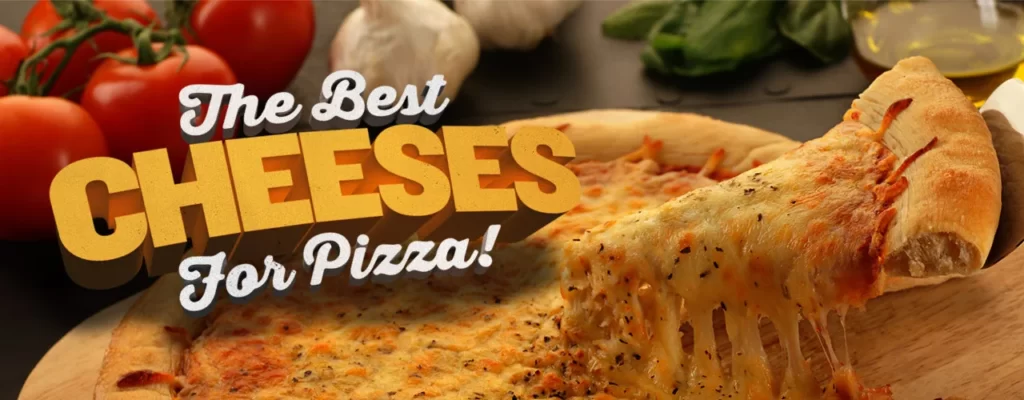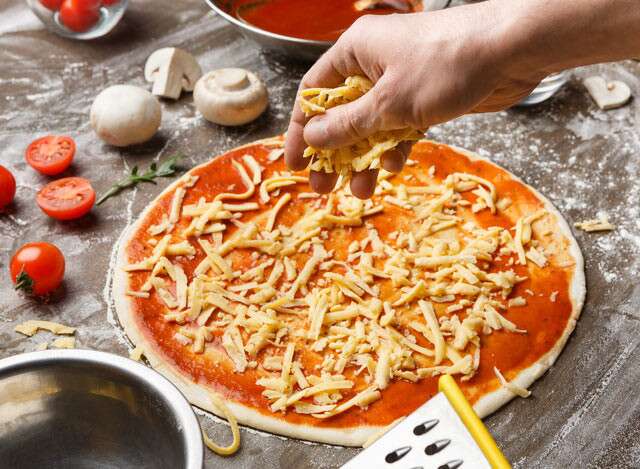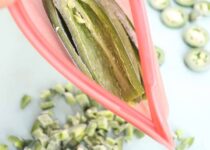Types of cheese for pizza
What is Cheese?
Cheese is made from curdled milk from cows, goats, or sheep. Many flavors and textures are available, from creamy and smooth to soft and crumbly. Cheese is an integral part of many cuisines all over the globe and can be used in a wide variety of dishes, including appetizers and desserts.
There are many types of cheese available, including cheddar, Swiss, Parmesan, and Gouda. Cheese can be eaten as a standalone ingredient or added to recipes. Cheese can be grated, sliced, diced, or melted.
Cheese is delicious and nutritious but can be dangerous if not properly prepared. Cheese, made from milk and other animal products, can contain bacteria that could make you sick. Make sure you follow safety precautions when making cheese at home.
Many people consider cheese an essential part of their diets. Cheese adds flavor to any dish, whether you’re enjoying soft cheeses with crackers or grated hard cheeses as an accompaniment to your favorite casseroles. If you are looking for new ideas or a way to spice up your lunch, add cheese to your menu.

How Do You Choose Cheese for Pizza?
Choosing the right cheese for pizza can be challenging due to all the variables you can consider. We’ve put together a list to help you consider it all.
- Browning Capability: A good pizza cheese must be able to go through the Maillard reaction to turn golden brown. It is not appealing to eat raw cheese!
- Melting Capacity: The more cheese melts, it can cover the pizza’s surface without leaving any lumps or becoming too thin.
- Stretchiness: Showing good strands after cutting pizza apart is a golden ticket to success!
- Fat Content: The fat content of cheese determines its ability to stretch and melt, so it is essential to choose cheeses with 35-40% fat.
- Moisture Content: The amount of liquid in cheese can significantly influence its browning ability. Brown cheese tastes better, as we have said before.
checkout Recipe for bbq cheese loaded pizza to relish your taste buds for great non veg pizza at home.
What is the Best Pizza Cheese?
Mozzarella cheese is, without a doubt, the most widely used cheese for pizza. It was made first from water buffalo milk in the Naples region. Original mozzarella had a concise shelf life due to its high moisture content. It was not easy to grate because of its texture. Instead, the cheese was cut into small pieces to be used.
Modern mozzarella is made from cow’s milk and has a lower moisture content. This makes it easier to use and prolongs its shelf life. Mozzarella comes in many different moisture levels and butterfats. It will take some experimentation to determine which mozzarella you prefer, as different mozzarellas melt and brown differently.
Fresh mozzarella is sold as balls of cheese soaked in water. This cheese is a bit different from regular mozzarella. Because it is too soft, it won’t grate and can turn sour on days and you can definitely use it to prepare a delicious pizza. Sometimes, fresh mozzarella is called scamorza. You can also use other cheeses for pizza. if you don’t have mozzarella then try its alternatives shared below for mouth watering pizza.

Try Some Different Flavors
-
Cheddar
Cheddar cheese is strong, powerful, influential, and full of character. It is second in popularity in the US behind mozzarella. Its history dates back to the 12th Century in England. Named after Cheddar Village in Cheddar County, it was a small community with caves and gorges that farmers used to cool their milk on hot days.
Legend has it that cheddar cheese was created when a milkmaid lost her milk pail in one cave. When she returned, she discovered that the milk had become perfect golden goodness.
Because of its low elasticity, cheddar cheese makes a great addition to pizzas. It doesn’t burn as quickly as mozzarella. Due to its low melting ability, it is not recommended to use cheddar only as a topping for pizza.
The fats separate from the solids when high heat is applied, making it ideal for creating pizza cheese blends. It adds color and tang to pizza. It pairs well with pepperoni and bacon, chicken, ham, chicken or pineapple, and capers.
-
Provolone
Provolone cheese was originally made in southern Italy, near Naples. It later spread to Veneto in the north and Lombardy (in the northeast). Because they are both made in the pasta filata or spun paste style, which involves a unique stretching process, it’s sometimes called mozzarella’s cousin.
Piccante and dolce are two types of this Italian cheese. Provolone dolce can be aged for a shorter time, adding a creamier texture to your pizza. Provolone piccante can be aged for longer periods and adds a crisper texture and sharper flavor to your pizza. Provolone, a semi-hard cheese, is highly popular in cheese blends.
It is often combined with mozzarella to make pizza. It is a semi-hard cheese with a high melting point and low to moderate stretchiness, depending on its age. It can be used on any pizza and paired with chicken, pesto, sausage, bacon, red peppers, tomato, or spinach.
-
Gorgonzola
Gorgonzola can be an excellent cheese for anyone willing to try a stronger flavor. It is not blue cheese, so it is not suitable for everyone. If you like its strong and fragrant flavor, you’ll love the pizza it brings. Gorgonzola is excellent when paired with mild cheeses like mozzarella or mild cheddar.
Adding too much cheese to your pizza is unnecessary, as it is a strong cheese. It is made from cow’s milk and is quite soft. You can spread it quickly to make pizza toppings. It is excellent with onions and vegetables as pizza toppings.
-
Goat’s cheese
Not everyone likes goat’s cheese. It tastes very different from cheese made with cow’s dairy and has a distinct and strong flavor. It can be an excellent addition to your pizza if you enjoy goat’s cheese. It is best to use goat’s cheese as an additional topping on pizzas and not as the sole cheese.
It can separate when heated. It is still challenging to melt goat cheese due to its high water content. It is a good alternative to mozzarella with an intense flavor. some people also like to make goat cheese sandwiches as a side dish with pizza.
-
Parmigiano Reggiano
Parmigiano Reggiano, a hard Italian cheese, is worth trying if you’re looking for something unique and special. This cheese is very similar in texture to Parmesan. It doesn’t melt as well as other softer cheeses, so it is best to be used as a topping rather than as an individual. Parmesan is a shorter-aged Parmigiano Reggiano.
It can be aged up to 36 months. Although it does not have a strong flavor, its unique flavor is due to aging. It is a strong and intensely nutty flavor that goes well with pizza. It’s not too salty and has a very crumbly texture.

-
Parmesan
Parmesan cheese is a well-known and long-standing tradition that dates back to the middle ages of the 13th and fourteenth Centuries. Legend has it that Benedictine monks created the hard cheese in the Parma Reggio region to increase the shelf life of large amounts of milk they produced around 900 years ago.
Parmesan production in Europe is strictly controlled. The official name for the authentic cheese is Parmigiano Reggiano. It is best eaten grated or shredded on freshly baked pizza. It is low in melting capability and has a high degree of stretchiness. This means that it snaps and snaps rather than stretching.
It is best not to mix it with cheeses because of its delicate flavor and dryness. It can burn easily, so don’t bake it. You can use it as a garnish to enhance your pizza’s flavor with its umami flavour. Parmesan cheese enhances the flavor of fresh toppings. It is great for Hawaiian, Sicilian, and Margherita pizzas. It pairs well with prosciutto and broccoli as well as provolone cheese.
-
Gouda
Gouda cheese, a traditional cheese, is still produced using the original recipe. It was first made in 1184. Gouda is a very popular cheese today. It is semi-hard and well-known for its rich, complex flavor and smooth texture. Gouda, which is made from cow’s dairy, is yellow. It has an aromatic taste that leaves you with a pleasant aftertaste.
This cheese is excellent for pizzas with pulled pork or barbecue chicken. Gouda can be purchased in either smoked or straight varieties to pick the one that best compliments the pizza’s flavor. It can melt from low to medium depending on age and has low stretchiness.
Gouda works on thin-crust pizzas and pairs well with barbecued meats due to its natural smokiness. It is also good with garlic, red onion, bacon, olives, and sausage.

FAQ’S
Why is cheddar cheese not happily used on pizza?
Because it is not able to withstand high heat, people don’t associate cheddar cheese with pizza. It is often an ingredient in many pizza cheese mixtures. Because it has a lower elasticity, cheddar is not as likely to blister as mozzarella.
How to use mozzarella cheese on pizza?
For Greek, Neapolitan, and Margherita pizzas, you can use mozzarella by itself. If you use it alone, be sure to cut it thinly. Drain any excess moisture. Because mozzarella is versatile, it’s the best cheese to add to a cheese mix.
Is Parmesan cheese good on pizza?
Parmesan is a very popular cheese used in Italian cuisine. Parmesan is a hard cheese which makes it different from other softer cheeses. It is excellent on pizza, especially when mixed with other cheeses. You need to use quite a bit of it to make it a good cheese. you can choose and use its alternatives if you are short on it while making pizza in your kitchen.

I am a kitchen expert and connoisseur of food with decades of cooking experience who loves to cook a variety of scrumptious food item to awaken the taste buds of people who eat my food. I know a lot about kitchen utensils and appliances and here to share my years of knowledge about the best kitchen products with you.
With his gumption, alacrity along with astute acumen to pick the authentic and best quality ingredients from across the world to make the scrumptious recipes which soothes the taste buds of eater has made him the name on which people can count on when it comes to cooking advice, world class meals and cuisines native to the different cities of world.
His unique ability improvise and make dishes with different raw produce and ingredients in less time which are delicious and relished by the guests has made Tushar leader in the arena of cooking.


